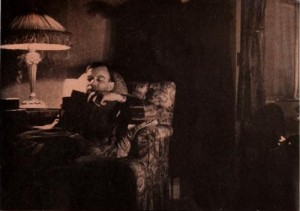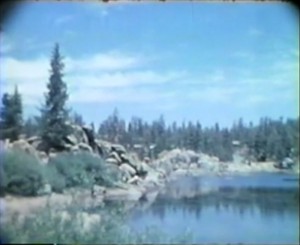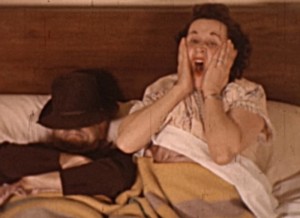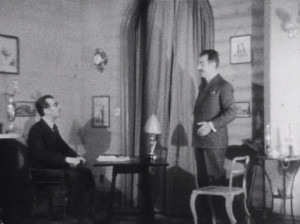
"Among the ten best, The Last Entry, running seven reels 16mm., is one of the most ambitious amateur photoplays ever undertaken and completed. The plot, requiring many elaborate interior sets, is based on a mystery story that opens with a house party. While a room is darkened for the projection of amateur films, one of the guests is murdered and all present may be suspected equally. The detective handling the case uncovers the fact that the murdered man, an author, has lived on blackmail effected by threats of exposure through publication, which throws suspicion on several of the guests of the house party who were discovered to be his victims. However, in the end, the murder is solved by screening the same pictures that were on the projector when it was committed. Although this plot offered great difficulties in the direction of large group scenes, the creation of the necessary lighting effects and the interpretation of the actors' roles, it is beautifully and suavely handled. In the film are several lighting treatments that may be listed as among the most effective ever achieved by amateurs. One chase sequence staged through long corridors, a large, dimly lighted attic and on the roof of the mansion at night in the rain, can be likened only to the effects secured in the best professional mystery photoplays. James F. Bell, jr., ACL, was director with Charles H. Bell, ACL, and Benjamin Bull, jr., ACL, cameramen and Lyman Howe, ACL, in charge of lighting." Movie Makers, Dec. 1932, 537-538.

"An edited home movie by Arthur H. Smith of Smith's later years, living with his wife Blanche in Big Bear Lake, California, including a description of his filmmaking process." Archive.org
"The Last Review, by George A. Ward, ACL, is an almost faultless example of a military motion picture, into which is woven a story that has the rare quality of evoking deep emotion from the audience. Actually, the film is a record of the camp life of the 105th Field Artillery of the New York National Guard, in its summer instruction quarters at Pine Camp, N. Y. Dramatically, it is the story of a Field Artillery private soldier and his friend, the oldest horse in the regiment. Condemned to be shot because of age and the approaching motorization of the command, the horse is reprieved and is given a review by the entire regiment in honor of "the artilleryman's best friend." The tale was not fictional, but actual. The hero was a member of the regiment, he loved the veteran horse and the review was actually held, not for purposes of filming but as a tribute. The film ends with the review, while actually the reprieve was only temporary and the equine actor has since been destroyed because of age. In this film, Mr. Ward exhibited cinematography of high quality and much incidental beauty. He contrived, as well, to give a military record that errs in no detail and that has no false note. To crown it all, he filmed a scenario, in itself moving and acted with complete sincerity." Movie Makers, Dec. 1934, 534.
"The Last Ride concerns the dangers of driving while drinking and dramatizes what happened to one man who lost control of himself when he lost his job. The photography is well done and some unusual angles help gives emphasis to the story" PSA Journal, Sept. 1965, 50.

Comedy about a married couple who appear to have overslept once again.
"doc. scientifico-turistico"/scientific-touristic documentary
"documentario con" -"interessante visione del lavoro nelle cave di marmo di Apuania"
documentary offering" -"interesting view of work in the marble quarries of Apuania."
documentario/documentary

Filmmaker Émile Gallet plays dual roles in this film as a antique dealer offering a promotion for his store's thirteenth year, and a customer who attempts to cash in on the prize. The film is spliced in two to allow Gallet to perform against himself, and features hand-written intertitles in both French and English.
Total Pages: 299